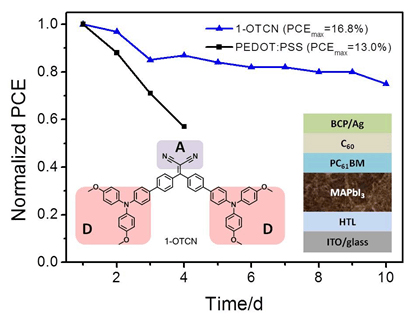| [1] Chai, L.; Zhong, M. Acta Phys. Sin. 2016, 65, 237902(in Chinese). (柴磊, 钟敏, 物理学报, 2016, 65, 237902.)
[2] Pan, B.; Zhu, Y.-Z.; Qiu, C.-J.; Wang, B.; Zheng, J.-Y. Acta Chim. Sinica 2018, 76, 215(in Chinese). (潘彬, 朱义州, 邱昌娟, 王冰, 郑健禺, 化学学报, 2018, 76, 215.)
[3] Kojima, A.; Teshima, K.; Shirai, Y.; Miyasaka, T. J. Am. Chem. Soc. 2009, 131, 6050.
[4] https: //www. nrel. gov/pv/assets/images/efficiency-chart. png.
[5] Zhao, C.; Ma, Y.; Wang, Y.; Zhu, X.; Li, H.-Z.; Li, M.-Z.; Song, Y.-L. Acta Chim. Sinica 2018, 76, 9(in Chinese). (赵聪, 马颖, 汪洋, 周雪, 李会增, 李明珠, 宋延林, 化学学报, 2018, 76, 9.)
[6] Chen, X.-Y.; Xie, J.-J.; Wang, W.; Yuan, H.-H.; Xu, D.; Zhang, T.; He, Y.-L. Shen, H.-J. Acta Chim. Sinica 2019, 77, 9(in Chinese). (陈薪羽, 解俊杰, 王炜, 袁慧慧, 许頔, 张焘, 何云龙, 沈沪江, 化学学报, 2019, 77, 9.)
[7] Li, C.-P.; Lv, X.-D.; Cao, J.; Tang, Y. Chin. J. Chem. 2019, 37, 30.
[8] Wang, Y.-L.; Chang, S.; Chen, X.-M.; Ren, Y.-D.; Shi, L.-F.; Liu, Y.-H.; Zhong, H.-Z. Chin. J. Chem. 2019, 37, 616.
[9] Etgar, L.; Gao, P.; Xue, Z.; Peng, Q.; Chandiran, A. Q.; Liu, B.; Nazeeruddin, M. K.; Grätzel, M. J. Am. Chem. Soc. 2012, 134, 17396.
[10] Liu, M.; Johnston, M. B.; Snaith, H. J. Nature 2013, 501, 395.
[11] Gao, P.; Grätzel, M.; Nazeeruddin, M. K. Energy Environ. Sci. 2014, 7, 2448.
[12] Green, M. A.; Ho-Baillie, A.; Snaith, H. J. Nature Photon. 2014, 8, 506.
[13] Liu, X.-D.; Li, Y.-F. J. Electrochem. 2016, 22, 315. (刘晓东, 李永舫, 电化学, 2016, 22, 315.)
[14] Urieta-Mora, J.; García-Benito, I.; Molina-Ontoria, A.; Martín, N. Chem. Soc. Rev. 2018, 47, 8541.
[15] Niu, G.-D.; Guo, X.-D.; Wang, L.-D. J. Mater. Chem. A 2015, 3, 8970.
[16] Hawash, Z.; Ono, L. K.; Raga, S. R.; Lee, M. V.; Qi, Y.-B. Chem. Mater. 2015, 27, 562.
[17] Leijtens, T.; Giovenzana, T.; Habisreutinger, S. N.; Tinkham, J. S.; Noel, N. K.; Kamino, B. A.; Sadoughi, G.; Sellinger, A.; Snaith, H. J. ACS Appl. Mater. Interfaces 2016, 8, 5981.
[18] Zhang, L.-Z.; Zhou, X.-Y.; Zhong, X.-W.; Cheng, C.; Tian, Y.-Q.; Xu, B.-M. Nano Energy 2019, 57, 248.
[19] Li, X.-D.; Wang, Y.-C.; Zhu, L.-P.; Zhang, W.-J.; Wang, H.-Q.; Fang, J.-F. ACS Appl. Mater. Interfaces 2017, 9, 31357.
[20] Sun, W.-H.; Li, Y.-L.; Yan, W.-B.; Peng, H.-T.; Ye, S.-Y.; Rao, H.-X.; Zhao, Z.-R. Liu, Z.-W. Bian, Z.-Q. Huang, C.-H. Chin. J. Chem. 2017, 35, 687.
[21] Zhang, Z,-G.; Yang, Y.-K.; Yao, J.; Xue, L.-W.; Chen, S.-S.; Li, X.-J.; Morrison, W.; Yang, C.; Li, Y.-F. Angew. Chem., Int. Ed. 2017, 129, 13688.
[22] Yan, W.-B.; Ye, S.-Y.; Li, Y.-L.; Sun, W.-H.; Rao, H.-X.; Liu, Z.-W.; Bian, Z.-Q.; Huang, C.-H. Adv. Energy Mater. 2016, 6, 1600474.
[23] Kim, Y. H.; Sachse, C.; Machala, M. L.; May, C.; Müller-Meskamp, L.; Leo, K. Adv. Funct. Mater. 2011, 21, 1076.
[24] Jeng, J.-Y.; Chen, K.-C.; Chiang, T.-Y.; Lin, P.-Y.; Tsai, T.-D.; Chang, Y.-C.; Guo, T.-F.; Chen, P.; Wen, T.-C.; Hsu, Y.-J. Adv. Mater. 2014, 26, 4107.
[25] Kim, J. H.; Liang, P.-W.; Williams, S. T.; Cho, N.; Chueh, C.-C.; Glaz, M. S.; Ginger, D. S.; Jen, A. K. Y. Adv. Mater. 2015, 27, 695.
[26] Lim, K.-G.; Kim, H.-B.; Jeong, J.; Kim, H.; Kim, J. Y.; Lee, T.-W. Adv. Mater. 2014, 26, 6461.
[27] Girotto, C.; Moia, D.; Rand, B. P.; Heremans, P. Adv. Funct. Mater. 2011, 21, 64.
[28] Hou, F.-H.; Su, Z.-S.; Jin, F.-M.; Yan, X.-W.; Wang, L.-D.; Zhao, H.-F.; Zhu, J.-Z.; Chu, B.; Li, W.-L. Nanoscale 2015, 7, 9427.
[29] Nie, W.-Y.; Tsai, H.; Asadpour, R.; Blancon, J.; Neukirch, A. J.; Gupta1, G.; Crochet, J. J.; Chhowalla, M.; Tretiak, S.; Alam, M. A.; Wang, H.; Mohite, A. D. Science 2015, 347, 522.
[30] Zhou, H.-P.; Chen, Q.; Li, G.; Luo, S.; Song, T.; Duan, H.; Hong, Z.-R.; You, J.-B.; Liu, Y.-S.; Yang, Y. Science 2014, 345, 542.
[31] Li, Y.; Xu, Z.; Zhao, S.-L.; Qiao, B.; Huang, D.; Zhao, L.; Zhao, J.; Wang, P.; Zhu, Y.-Q.; Li, X.-G.; Liu, X.-C.; Xu, X.-R. Small 2016, 12, 4902.
[32] Yang, L.-Y.; Cai, F.-L.; Yan, Y.; Li, J.-H.; Liu, D.; Pearson, A. J.; Wang, T. Adv. Funct. Mater. 2017, 27, 1702613.
[33] Huang, C.-Y.; Fu, W.-F.; Li, C.-Z.; Zhang, Z.-Q.; Qiu, W.-M.; Shi, M.-M.; Heremans, P.; Jen, A. K.-Y.; Chen, H.-Z. J. Am. Chem. Soc. 2016, 138, 2528.
[34] Xue, R.-M.; Zhang, M.-Y.; Xu, G.-Y.; Zhang, J.-W.; Chen, W.-J.; Chen, H.-Y.; Yang, M.; Cui, C.-H.; Li, Y.-W.; Li, Y.-F. J. Mater. Chem. A 2018, 6, 404.
[35] Wang, J.-Y.; Liu, K.; Ma, L.-C.; Zhan, X.-W. Chem. Rev. 2016, 116, 14675.
[36] Song, Z.-H.; Wang, S.-R.; Xiao, Y.; Li, X.-G. Acta Phys. Sin. 2015, 64, 033301(in Chinese). (宋志浩, 王世荣, 肖殷, 李祥高, 物理学报, 2015, 64, 033301.)
[37] Zhang, H.; Wu, Y.-Z.; Zhang, W.-W.; Li, E.-P.; Shen, C.; Jiang, H.-Y.; Tian, H.; Zhu, W.-H. Chem. Sci. 2018, 9, 5919.
[38] Shen, C.; Wu, Y.-Z.; Zhang, H.; Li, E.-P.; Zhang, W.-W.; Xu, X.-J.; Wu, W.-J.; He, T.; Zhu, W.-H. Angew. Chem. Int. Ed. 2019, 58, 3784.
[39] Urieta-Mora, J.; García-Benito, I.; Molina-Ontoria, A.; Martín, N. Chem. Soc. Rev. 2018, 47, 8541.
[40] Li, H.-R.; Fu, K.-W.; Hagfeldt, A.; Grätzel, M.; Mhaisalkar, S. G.; Grimsdale, A. C. Angew. Chem. Int. Ed. 2014, 53, 4169.
[41] Yang, D.; Sano, T.; Yaguchi, Y.; Sun, H.; Sasabe, H.; Kido, J. Adv. Funct. Mater. 2018, 29, 1807556.
[42] Bi, C.; Wang, Q.; Shao, Y.-C.; Yuan, Y.-B.; Xiao, Z.-G.; Huang, J.-S. Nat. Commun. 2015, 6, 7747.
[43] Yu, H.-Z. Acta Phys. Sin. 2012, 61, 087204(in Chinese). (於黄忠, 物理学报, 2012, 61, 087204.)
[44] Davey, M. H.; Lee, V. Y.; Miller, R. D.; Marks, T. J. J. Org. Chem. 1999, 64, 4976. |
